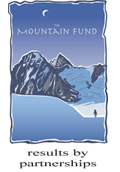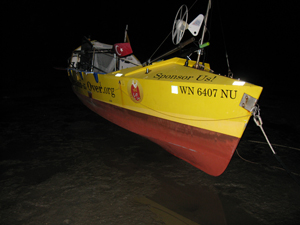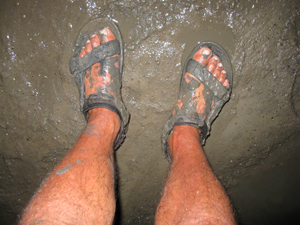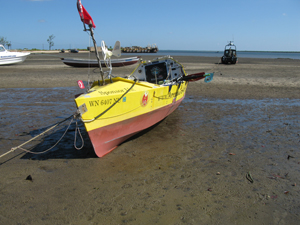|
Landfall story...
May 5, 2011 16.2353S,39.9017E
I see that Nancy posted a dispatch sharing the good news with you. Wonderful of her... and yes, I do feel relieved to be on shore, having reached mainland Africa after a challenging 26 days on the Mozambique Channel. My landing took place at Angoche, also known as Antonio Enes on the shores of Mozambique, to conclude the first ever mainland to mainland crossing of the complete Indian Ocean.
I am finally posting this dispatch from Nacala. The two Internet cafés in town were closed with no web access over the last few days. My challenges to post dispatches and to handle email from my expedition PDA remain; it is a software issue. If I find a place to connect my own laptop to the Internet, I may be able to solve that problem.
If you have Google Earth, you will find a smaller file with only the Indian Ocean crossing at this link. The entire circumnavigation effort to date can be studied at this link where you will see that my actual track in red crosses near Cap St Andre of Madagascar its own antipodal track shown in green. The antipode of this intersection is located on the other side of the globe, at a diametrically opposite position east-southeast of Hawaii. Including a pair of antipodes in my human powered path is an absolute requirement of a true circumnavigation. These two intersection points represent the first antipodal pair that I have accomplished. I anticipate that I will have at least three more pairs of antipodes on my circumnavigation route.
It appears that I may have run past the gauntlet of pirates as well. I found out after arrival that around Christmas time, there were two piracy attempts east of Beira which is another 360 nm southwest of Angoche where I landed on April 20. The information I had when I left Mahajanga was that there were no known piracy threats along my path. I had been under the impression that I was far south of the piracy zone; I routinely turned on my AIS and my navigation light at night during the crossing. Had I known that pirates had reached that far south earlier, I would have remained in a stealthy listening mode, also practiced total blackout after sunset. I was lucky...
As the winds reverse in March and April before the southwest monsoons gain strength, there is a period of relatively calm seas in the Mozambique Channel. This creates a window of opportunity for pirates. There were reports of piracy in earlier years around Mayotte in March, but Beira earlier is really a reach for these Somali bandits. They sometimes use a previously captured vessel as a mother ship from which to launch fast skiffs with outboard engines. In addition to extended range, this also gives them some stealth, appearing to be a regular merchant vessel, to sneak past the Combined Task Force vessels and their aerial surveillance.
As Nancy posted, I was on anchor near Angoche until the morning of the last day. I waited for the winds to subside a bit before beginning to row. Before then, I would pull anchor and row some each day to see how the boat behaved then decide whether to battle further with the wind waves and the swells. I had exited the fast flowing Mozambique Current which ran southwest parallel to the shore, in favor of the shallow waters of the continental shelf of Mozambique allowing me to drop anchor. Having lost the favorable current by doing so, I then needed a break in the southerly winds to bring my boat to port.
On April 20, the swells seemed to settle on my southeast even though the wind was still blowing from the south. When I began to row, I was able to keep the wind behind my right shoulder, on the port side of my bow, blowing into my right ear the whole time. The result was about 1.5 knot average speed due westsouthwest and the remaining distance was only about 14 nm to reach the port of Angoche. For two days while waiting on anchor, the fishermen piled on large dories or on traditional sailing dhows with triangular sails would come by and check on me on their way to a nearby reef; some even offered me a tow, gesturing with a coiled line in hand. “No problem?” was the key question that they would throw at me when I turned down their kind offers of help.
I had timed my row with the incoming tide. The range of the tide would be 4.2 meters that day. As I approached the shallower east entrance of the westerly extending channel leading into port, I picked up speed with the tide, averaging 2.5-3.0 knots. The swells and the wind waves were now turning into a messy chop as they ran over the sandbars. I had been warned that these sandbars shifted over time and although the entrance was marked by buoys, I did not have the luxury of navigating based on these markers. Given the little draft that my rowboat had, I easily cleared the bottom, but the chop was difficult. I had a better time if I received the chop from the bow. So, I kept rowing to maintain my bow into the southerly wind and the tide carried me in due west at 2.5 knots.
The port was not obvious. No buildings stood out. I passed a modern purse-seine fishing vessel tied alongside a derelict barge at the end of a dirt pier. The barge may have been filled with soil and set in place to form the end of this pier. Eight small tugboats were parked bow first and tied to each other on the lee side. I dropped anchor at sunset with a significantly shortened rode line at about 50 meters from the tugboats. I did not hail on VHF given the impending darkness; I tied my yellow Q-flag to indicate that I wanted Customs clearance then retired until daylight.
Around ten o'clock at night, the boat's pitch in the sheltered waters behind the pier changed a bit losing its range of motion. It seemed to stop short then sway again. I quickly reasoned that with the ebbing tide, the tip of my rudder was making contact with the ground below. The rudder extended about 60 cm further down than the skeg which ran the length of the boat for directional stability. There was still another hour before the low tide. If I left the rudder in place, the boat would be cranked over on its side, likely causing damage.
I stood up on my mattress through the small rear hatch of the cabin then attempted to remove the rudder by pulling its pin. The hatch was by my knees when I stood up. My position at the far end of the boat made the stern sit lower in the water of course, setting the rudder tip firmly on the bottom. I was able to pull the long pin past its bottom and middle hinges, but as soon as I pulled the pin out of the middle hinge, the boat moved forward levering the rudder away, now held only by the top hinge. The pin jammed in the top hinge, would not come out, and if I stood there any longer, the hinge was going to bend or rip out of the transom. I had to step overboard.
I stripped down on deck for a skinny dip then stepped over on the port side into waist deep water. I stood on what felt like mud under my feet. Without my weight above the stern, the rudder was freed of the bottom and the pin came out very easily. I secured the rudder outside the boat, resting it horizontally above water on the transom. I climbed back on board, rinsed the salt water off my body and mud off my feet, dressed up again and got back in the cabin. I was reading and monitoring the boat's behavior...
Before long, the sea had completely receded from around my boat stranding it on the mud after the 4.2 meter tide. The lean was not that bad; I could rest in the cabin comfortably. I had not officially made landfall even though I had walked on the bottom to remove the rudder. This was a ridiculous case of arrival, which probably required a revision of the landfall rules at the Ocean Rowing Society. To make matters even more ridiculous, my clock was still running since departure from Mahajanga adding hours to my "rowing time" at sea. I decided to not wait for the morning and walked less than 100 meters on the mud to a point above the high tide line then to the road on the dirt pier. I marked a waypoint next to a tree and officially ended my crossing at midnight local time. This would be the same point from which I would begin to bicycle north. I reported this as my time of landfall, asking the ORS to stop the clock.
The walk on the mud was not such a bright idea though. I could have stepped on sharp objects like broken glass buried in the mud and cut my feet. I needed such silly injuries like I needed a hole in my head. Unforeseen wounds like that could cause unnecessary delays at the very best and I had to be conservative until my return to Bodega Bay to conclude the circumnavigation. I fortunately had more fresh water on the boat to wash the mud off my feet before going to sleep.
Now, I had to worry about securing the boat and resolving the logistical challenge to eventually move it to Namibia.
Erden.
.
.
|







 Boat was resting on the mud at midnight.
Boat was resting on the mud at midnight.
 It was a muddy mess where the sea had been.
It was a muddy mess where the sea had been.
 Boat near maritime police building at low tide. Tugboats are resting on the mud in the distance.
Boat near maritime police building at low tide. Tugboats are resting on the mud in the distance.